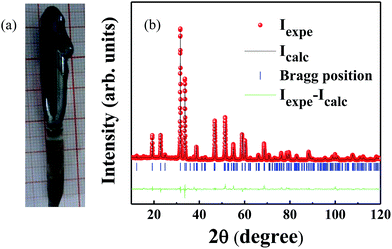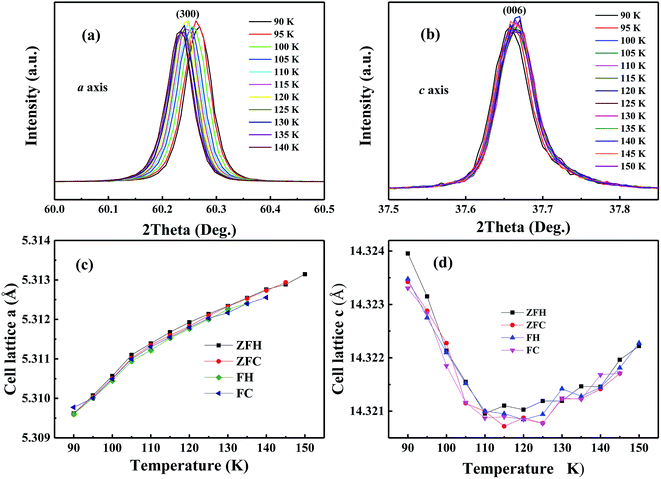 Open Access Article
Open Access ArticleCreative Commons Attribution 3.0 Unported Licence
Single crystal growth of Mn4Nb2O9 and its structure-magnetic coupling
Yiming Caoabc,
Maolin Xiangb,
Zhenjie Fengb,
Baojuan Kangb,
Jincang Zhangde,
Nicolas Guiblinc,
Wei Renbde,
Brahim Dkhil*c and
Shixun Cao *bde
*bde
aCenter for Magnetic Materials and Devices and Key Laboratory for Advanced Functional and Low Dimensional Materials of Yunnan Higher Education Institute, Qujing Normal University, 655011, China
bDepartment of Physics, International Center of Quantum and Molecular Structures, Shanghai University, Shanghai 200444, China. E-mail: sxcao@shu.edu.cn
cLaboratoire Structures, Propriétés et Modélisation des Solides, CentraleSupélec, CNRS-UMR 8580, Université Paris-Saclay, 92295 Châtenay-Malabry Cedex, France. E-mail: brahim.dkhil@centralesupelec.fr
dMaterials Genome Institute, Shanghai University, Shanghai 200444, China
eShanghai Key Laboratory of High Temperature Superconductors, Shanghai University, Shanghai 200444, China
First published on 1st March 2017
Abstract
A single crystal of Mn4Nb2O9 of about 8 mm in diameter and 30 mm in length was successfully grown by a newly designed one-step method based on the optical floating zone technique. Clear Laue spots and sharp XRD Bragg reflections attest the good crystal quality. The antiferromagnetic phase transition at TN = 108.4 K of the Mn4Nb2O9 single crystal was observed along the c axis, which contrasts with Co4Nb2O9 belonging to the same structural family. Structural changes with a-axis shrinkage and c-axis expansion at TN demonstrate a significant and anisotropic magnetostriction effect.
Introduction
Recently, A4B2O9 (A = Co, Mn, B = Nb, Ta) have attracted more attention due to their spin flop phase transition,1 magneto-dielectric effect1 and magnetoelectric effect.2 Mn4Nb2O9 was first prepared and studied by Bertaut et al.3 X-ray diffraction (XRD) studies showed that Mn4Nb2O9 possesses a trigonal crystal structure (space group P![[3 with combining macron]](https://www.rsc.org/images/entities/char_0033_0304.gif) c1) with two formula units per cell. The magnetic structure of Mn4Nb2O9 has also been reported by Bertaut et al.3 and further confirmed by Schwarz et al.4 According to the results of neutron diffraction, below Néel temperature (about 125 K), Mn spins order along the c axis and form chains along the lines
c1) with two formula units per cell. The magnetic structure of Mn4Nb2O9 has also been reported by Bertaut et al.3 and further confirmed by Schwarz et al.4 According to the results of neutron diffraction, below Néel temperature (about 125 K), Mn spins order along the c axis and form chains along the lines  (+spins) and
(+spins) and  (−spins) with antiparallel inter-chain coupling.
(−spins) with antiparallel inter-chain coupling.
The study and confirmation of the magnetoelectric effect in these compounds were conducted by Fischer et al.5 Furthermore, magneto-dielectric effect and magnetic-induced electric polarization were observed in polycrystalline Mn4Nb2O9 by Fang et al.6 However, detailed data about the physical properties of the single crystal Mn4Nb2O9 are still lacking to further understand this material. In this work, we grow successfully single crystal of Mn4Nb2O9 samples by our newly designed one-step method based on the optical floating zone technique. A single crystal with well-defined crystallographic orientation allows us to investigate the anisotropy of its magnetic and structural properties. The crystallographic orientations were identified by both Laue X-ray photography and X-ray diffraction. An antiferromagnetic (AFM) transition is found at Néel temperature TN = 108.4 K. In contrast to Co4Nb2O9,7 the AFM order of Mn4Nb2O9 single crystal is along c axis and the spin flop transition does not occur even with a magnetic field up to 7 T. A structural phase transition is observed with a-direction shrinkage and c-direction expansion around 110 K, which corresponds exactly to the TN of Mn4Nb2O9. The magnetic structure of our AFM Co4Nb2O9 single crystal is different from a collinear arrangement with spin parallel to the trigonal axis as proposed previously by Bertaut et al.3 and resembles the Co2+ magnetic moments found to be almost lying in the basal plane by Khanh et al.8 But the main difference between the samples, which is responsible for the different easy axis directions, is not clear yet.
Experimental details
Polycrystalline Mn4Nb2O9 decomposes easily, so that it is difficult to synthesize by conventional solid-state reaction technique. Here, a one-step method based on the optical floating zone technique was designed to grow the single crystal of Mn4Nb2O9. The stoichiometric mixtures of Nb2O5 (99.99% @ Alfa Aesar) and MnCO3 (99.9% @ Alfa Aesar) powders were well grounded and calcined at a temperature of 900 °C for 6 h under the protection of Ar gas flow. The milled pre-sintered material (that is a mixture of MnNb2O6 and Mn3O4 confirmed by XRD) was isostatically pressed into a cylindrical shape of 70 mm length and 8 mm diameter at 70 MPa and sintered at 1100 °C at a rate of 2 °C min−1 for 12 h. Single crystal of Mn4Nb2O9 was then successfully grown in an optical floating zone furnace (FZ-T-10000-H-VI-P-SH, Crystal Systems Corp.) with 4 × 1000 W halogen lamps installed as infrared radiation sources by using the rod of the above prepared mixture. The temperature of the molten zone focused by mirrors was precisely controlled by adjusting the power of the lamps. During the growth, the molten zone was moved upwards at a rate of 5 mm h−1, with the seed rod (lower shaft) and the feed rod (upper shaft) counter rotating at 30 rpm in Ar gas flow by 4 L min−1. A single crystal of Mn4Nb2O9 of about 8 mm in diameter and 30 mm in length with black shining surface was obtained, as shown in Fig. 1a. The room temperature crystal structure was characterized by XRD (XRD, D/max2200) using Cu Kα radiation. Low temperature XRD data were collected with a high accuracy home-made Bragg–Brentano diffractometer equipped with a copper source monochromatic radiation λ = 1.54056 Å issued from a 18 kW Rigaku rotating anode, from 90 K to 900 K under air atmosphere by using a cryofurnace and a furnace with an accuracy better than 0.1 K and 2 K, respectively. Variation of temperature steps is 5 K from 90 K to 150 K. The step is 0.02° and integration time is 4 s, respectively. Crystallographic orientation was determined by using back-reflection Laue X-ray photography with tungsten target (with the X-ray beam of 0.5 mm in diameter) and additionally confirmed by standard XRD. Measurements of the magnetization were conducted using a Physical Property Measurement System (PPMS-9, Quantum Design Inc.) with Vibrating Sample Magnetometer (VSM) option. The temperature and magnetic field increasing/decreasing rates are 1.5 K min−1 and 0.01 T s−1, respectively. The temperature and magnetic field ranges are 2–400 K and −9 to 9 T, respectively. The sensitivity of the VSM is 10−9 A m2.Results and discussion
Rietveld method9 as implemented in the FullProf program10 was used for the refinement of the structure parameters, based on the powder (ground single crystal by agate mortar) XRD data of Mn4Nb2O9 as shown in Fig. 1b. The powder diffraction patterns can be assigned to a single-phase corundum trigonal crystal structure11 with P![[3 with combining macron]](https://www.rsc.org/images/entities/char_0033_0304.gif) c1 space group which is similar to that of Co4Nb2O9.2,7,8 The lattice parameters obtained are a = b = 5.32449 ± 0.00016 Å and c = 14.32222 ± 0.00043 Å. The unit cell of Mn4Nb2O9 is thus larger than that of Co4Nb2O9 and this is due to the slightly larger ionic radius of Mn2+ with respect to that of Co2+.
c1 space group which is similar to that of Co4Nb2O9.2,7,8 The lattice parameters obtained are a = b = 5.32449 ± 0.00016 Å and c = 14.32222 ± 0.00043 Å. The unit cell of Mn4Nb2O9 is thus larger than that of Co4Nb2O9 and this is due to the slightly larger ionic radius of Mn2+ with respect to that of Co2+.
Fig. 2a and b show the XRD patterns with θ–2θ scans recorded on slices cut perpendicular to the a and c axes which have been identified by using back-reflection Laue photograph (see inset of Fig. 2a and b). As it is shown in Fig. 2a and b, four (h00) (h = 1, 2, 3, 4) and six (00l) (l = 2, 4, 6, 8, 10, 12) reflections, respectively can be easily indexed. The sharp XRD peaks with no impurity or misorientation detected as well as the clear Laue diffraction spots imply high quality Mn4Nb2O9 single crystal.
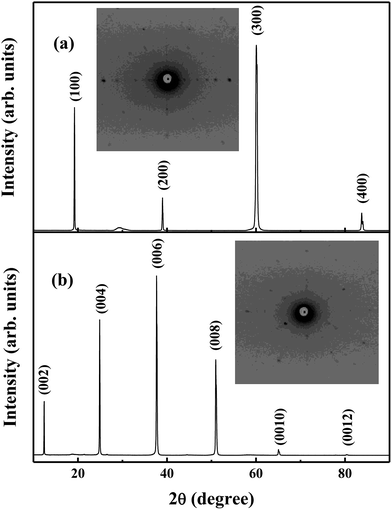 | ||
| Fig. 2 XRD patterns of single crystal Mn4Nb2O9 along the a (a) and c (b) axis. The insets show corresponding Laue photographs of the a and c axis. | ||
In order to check the magnetic properties of Mn4Nb2O9, and because Mn4Nb2O9 displays nonequivalence between a axis and c axis, similarly to Co4Nb2O9, temperature dependence of Ma(T) and Mc(T) was measured under a small magnetic field H = 0.01 T applied along a and c axes of Mn4Nb2O9 single crystal as shown in Fig. 3a. Mn4Nb2O9 shows a strong magnetic anisotropy which leads to dramatically different temperature dependence of Ma(T) and Mc(T). With the decrease of the temperature, Mc(T) exhibits a magnetic Néel transition around TN = 108.4 K, which corresponds to the previously observed AFM transition in polycrystalline Mn4Nb2O9, but for which the orientation of the magnetic moments6 could not be identified. Below TN, Mc(T) decreases linearly with temperature down to 3 K. On the contrary, Ma(T) presents the same increasing trend upon cooling of temperature even below TN. This suggests that the antiferromagnetic axis of Mn4Nb2O9 is not same as that of Co4Nb2O9 along a axis and therefore, the magnetic structure of both compounds must be different. The magnetic structure of Mn4Nb2O9 given by Bertaut et al.3 where Mn spins align to the c axis and form chains along the lines  (+spins) and
(+spins) and  (−spins) with antiparallel inter-chain coupling can be thus used to explain the magnetic measurements of Mn4Nb2O9.
(−spins) with antiparallel inter-chain coupling can be thus used to explain the magnetic measurements of Mn4Nb2O9.
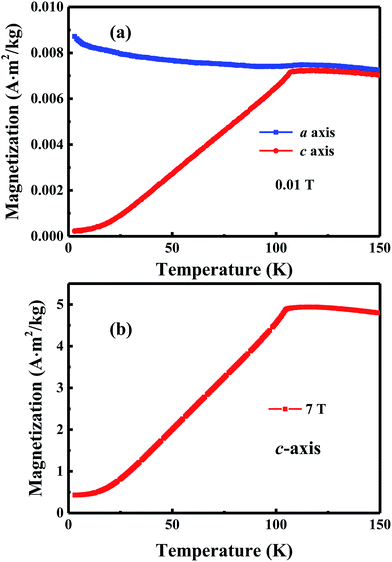 | ||
| Fig. 3 Temperature dependence of the magnetization M(T) of Mn4Nb2O9 measured along a and c axis under an applied magnetic field of 0.01 T (a) and along c axis under a magnetic field of 7 T (b). | ||
To reveal the occurrence of the spin flop in Mn4Nb2O9 single crystal, we further measured magnetization curves under a strong external field (H = 7 T) along c axis. As shown in Fig. 3b, the behavior is different from Co4Nb2O9 as Mc(T) here shows no change with comparison to Mc(T) measurement under a field of H = 0.01 T. This demonstrates that the spin flop does not occur along c axis even though the applied magnetic field is up to 7 T.
Furthermore, the magnetic field dependences of the magnetization along a and c axes at 5 K were measured (Fig. 4). A linear Ma(H) curve with no slope abnormality is shown in Fig. 4a indicating that there is no antiferromagnetic ordering component along the a axis. In Fig. 4b, although there is a deviation from the linear behavior in Mc(H) curve at around 4 T, the induced magnetization is not reached up to 7 T which confirms that the critical magnetic field to induce the spin flop transition in single crystal Mn4Nb2O9 is larger than 7 T. There is no doubt that the critical magnetic field of single crystal Mn4Nb2O9 is much larger than 0.75 T found in single crystal Co4Nb2O9. The Zeeman energy which induces the spin flop can be expressed as:12
EZeeman = −μ0MNetHExtcos![[thin space (1/6-em)]](https://www.rsc.org/images/entities/char_2009.gif) θ θ
| (1) |
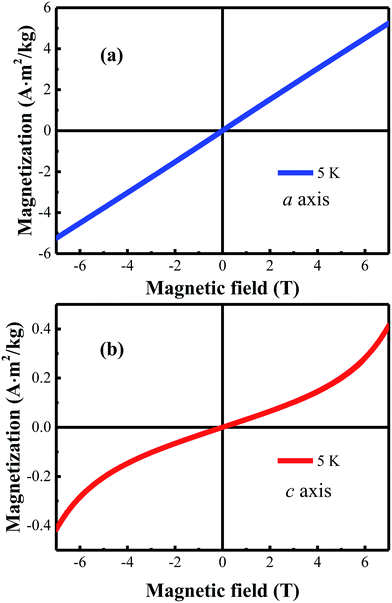 | ||
| Fig. 4 Magnetic field dependence of the magnetization M(H) of Mn4Nb2O9 measured along a (a) and c (b) axis at 5 K. | ||
In order to check if the antiferromagnetic phase transition is accompanied with structural changes, the (300) and (006) Bragg reflections along a and c axis, respectively were measured by varying the temperature. As shown in Fig. 5a, the (300) Bragg reflections shift towards higher 2θ degrees by decreasing the temperature. In contrast to (300) Bragg reflections, the (006) Bragg reflections first shift to higher 2θ angles on cooling and then shift to lower 2θ degrees as shown in Fig. 5b. The peak positions of the Bragg reflections can then be obtained by fitting the corresponding (300) and (006) Bragg reflections using Gaussian function fitting. The a and c lattice parameters as a function of temperature between 90 K and 150 K are plotted in Fig. 5c and d, respectively. As the temperature decreases, there is a structural change of a shrinkage along a direction while an expansion along c direction below around 110 K which is exactly the TN of Mn4Nb2O9 evidenced above using magnetic measurements. There is therefore an obvious magnetostriction effect occurring at the AFM phase transition. This result is appealing to further investigations for instance by studying the magnetic behavior under pressure/stress and/or the resulting strain under magnetic field. Furthermore, if the structure-magnetic coupling is strong enough, it opens the door towards strain-engineering of the magnetism in Mn4Nb2O9. Finally, we also applied an electric field of 20 kV cm−1, within field cooling (FC) and field heating (FH) regimes and followed the Bragg reflections versus temperature (Fig. 5c and d). However, there is no distinction between the data under electric field (FC, FH) and those without or zero (ZFC and ZFH) field regime, indicating that no magnetoelectric coupling exists in Mn4Nb2O9.
Conclusion
In summary, we have successfully synthesized Mn4Nb2O9 single crystal with a single phase of corundum-type structure by a one-step method based on the optical floating zone technique. Characterizations of the crystal by X-ray diffraction and Laue photographs analysis show the good quality of the crystal. An antiferromagnetic phase transition is found at Néel temperature TN = 108.4 K. In contrast to Co4Nb2O9, such AFM ordering is along c axis and the spin flop transition cannot be achieved with magnetic field up to 7 T. A structural modification with shrinking of the a direction and expansion of c direction takes place at TN and indicates a magnetostriction effect. We also applied an electric field across the magnetic transition showing that no magnetoelectric coupling exists. Further work is needed to study the interaction between structure and magnetism in Mn4Nb2O9 single crystal.Acknowledgements
This work is supported by the National Natural Science Foundation of China (NSFC, No. 51372149, 51672171, 11574194), the National Key Basic Research Program of China (Grant No. 2015CB921600), Eastern Scholar Program from Shanghai Municipal Education Commission, and the Science and Technology Commission of Shanghai Municipality (No. 16DZ2260600).References
- T. Kolodiazhnyi, H. Sakurai and N. Vittayakorn, Appl. Phys. Lett., 2011, 99, 132906 CrossRef.
- Y. Fang, Y. Q. Song, W. P. Zhou, R. Zhao, R. J. Tang, H. Yang, L. Y. Lv, S. G. Yang, D. H. Wang and Y. W. Du, Sci. Rep., 2014, 4, 3860 CAS.
- E. F. Bertaut, L. Corliss, F. Forrat, R. Aleonard and R. Pauthenet, J. Phys. Chem. Solids, 1961, 21, 234–251 CrossRef.
- B. Schwarz, D. Kraft, R. Theissmann and H. Ehrenberg, J. Magn. Magn. Mater., 2010, 322, L1–L3 CrossRef CAS.
- E. Fischer, G. Gorodetsky and R. M. Hornreich, Solid State Commun., 1972, 10, 1127–1132 CrossRef CAS.
- Y. Fang, W. P. Zhou, S. M. Yan, R. Bai, Z. H. Qian, Q. Y. Xu, D. H. Wang and Y. W. Du, J. Appl. Phys., 2015, 117, 17b712 CrossRef.
- Y. Cao, Y. Yang, M. Xiang, Z. Feng, B. Kang, J. Zhang, W. Ren and S. Cao, J. Cryst. Growth, 2015, 420, 90–93 CrossRef CAS.
- N. D. Khanh, N. Abe, H. Sagayama, A. Nakao, T. Hanashima, R. Kiyanagi, Y. Tokunaga and T. Arima, Phys. Rev. B, 2016, 93, 075117 CrossRef.
- H. Rietveld, Acta Crystallogr., 1967, 22, 151–152 CrossRef CAS.
- J. Rodriguez-Carvajal, Phys. B, 1993, 192, 55–69 CrossRef CAS.
- M. Ye and D. Vanderbilt, Phys. Rev. B, 2016, 93, 134303 CrossRef.
- Y. Cao, S. Cao, W. Ren, Z. Feng, S. Yuan, B. Kang, B. Lu and J. Zhang, Appl. Phys. Lett., 2014, 104, 232405 CrossRef.
- K. Tomiyasu, J. Fukunaga and H. Suzuki, Phys. Rev. B: Condens. Matter Mater. Phys., 2004, 70, 214434 CrossRef.
| This journal is © The Royal Society of Chemistry 2017 |

